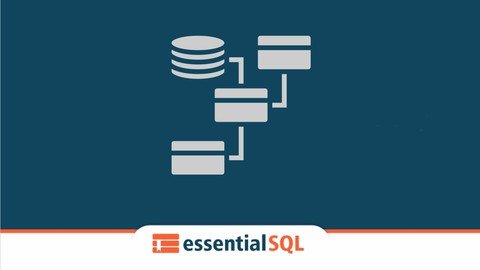
Published 8/2022
MP4 | Video: h264, 1280x720 | Audio: AAC, 44.1 KHz
Language: English | Size: 1.42 GB | Duration: 3h 39m
SQL Relational Database Design Explained in Simple English for MySql, PostgreSQL, and SQL Server
What you'll learn
Create conceptual database model based upon user requirements to depict relationships between business entities.
Diagram a relational database design with entity–relationship diagrams (ERDs) using crow's foot notation to enforce referential integrity.
Evaluate tables for compliance to third normal form and perform normalization procedures on noncompliant tables.
Restructure spreadsheet like data into good database form.
Design and implement relational databases using tables, keys, relationships, and SQL commands in MySQL, PostgreSQL, and SQL Server to meet user requirements.
Be able to express and communication database design concepts with others.
Know the reasons why a relational database is organized into many separate tables.
Requirements
No programming experience is needed.
No prior knowledge of MySQL, SQLServer, PostgreSQL or Oracle is required!
Appreciate basic database concepts such as knowing about columns, rows, and tables.
Interest in a class hyper-focused on database design -- nothing else!
Description
This course is perfect if you're looking for entry-level course to learn relational database table design. Its singular purpose is to teach you relational database logical design using simple to understand English.Join me as we work through Lou's, the owner of several pizza shops, to design and create a database he can use to track is business.In this Course you will Learn to:Create a conceptual data model based on Lou's Pizza Shops' requirements.Use ER (Entity-Relationship) diagrams to design database tables and relationship between one another.Appreciate and design around data modification anomalies.Identify a properly formed database table.Answer common interview questions related to normalization (huge).Spot a poorly designed table.Communicate with others about table design.Finally understand those confounding normalization rules!Identify database normalization issues within our design and know how to fix them.Use an ERD (Entity Relationship Diagram) to create database scripts.Nothing is worse thanBeing excited to learn something new but not knowing where to start.Wasting time learning the wrong features.Being overwhelmed with options and not know which to use.Imagine Having...Knowledge - Knowing how to quickly understand database design to take your SQL to the next level.Confidence - Feeling good that you're on the right track.Accomplishment - Having a sense of accomplishment that you've learned something most cannot.Fun - Having fun learning databases!By the time you've completed this course you'll be able to design and implement relational databases using tables, keys, relationships, and SQL commands in MySQL, PostgresSQL, and SQL Server to meet user and operational needs.
Overview
Section 1: Introduction
Lecture 1 Welcome!
Lecture 2 Pizza DB, Helping Lou
Section 2: Requirements
Lecture 3 Introduction
Section 3: Optional Tools
Lecture 4 Software Tools I Used
Section 4: Conceptual Model
Lecture 5 What is a Conceptual Model
Lecture 6 Conceptual Model Walk Through
Section 5: Relational Table Design
Lecture 7 Introduction
Lecture 8 Entity Relationship Diagrams
Section 6: Database Normalization
Lecture 9 What is Database Normalization?
Lecture 10 Reasons for Database Normalization
Lecture 11 The Three Normal Forms
Lecture 12 The First Normal Form Explained
Lecture 13 The First Normal Form Design Review
Lecture 14 The Second Normal Form Explained
Lecture 15 The Second Normal Form Design Review
Lecture 16 The Third Normal Form
Lecture 17 The Third Normal Form Design Review
Section 7: Relational Database Design In Practice
Lecture 18 Introduction
Lecture 19 ER Diagramming - Initial Draft Part 1
Lecture 20 ER Diagramming - Initial Draft Part 2
Lecture 21 ER Diagramming - Initial Draft Part 3
Lecture 22 Database Normalization Review - Part 1
Lecture 23 Database Normalization Review - Part 2
Lecture 24 Beginning Database Design Patterns
Section 8: Database Creation
Lecture 25 Data Definition Language Concepts
Lecture 26 Creating Tables and Columns
Lecture 27 Defining Table Constraints
Lecture 28 DDL Script Review
Students baffled by their professor's database normalization explanations,DBAs seeking common sense definitions of database normal forms.,Anyone studying MySQL, Oracle, or SQL Server wanting to become a better database designer.,People preparing for SQL related job interviews.,Anyone looking to take a class whose singular purpose is to teach you database design.,Anyone who doesn't have time to weed through dense textbooks trying to sort out academic explanations.
Homepage
https://www.udemy.com/course/relational-database-design-sql/
https://rapidgator.net/file/5864d687ee949f17cec36889079aabeb/cjqmf.Relational.Database.Design.2022..Udemy.part1.rar.html
https://rapidgator.net/file/911e6b815e333f669d1d49cb1c413eb5/cjqmf.Relational.Database.Design.2022..Udemy.part2.rar.html

https://uploadgig.com/file/download/51f87b8425C14ffa/cjqmf.Relational.Database.Design.2022..Udemy.part2.rar
https://uploadgig.com/file/download/9c63091931Cadab6/cjqmf.Relational.Database.Design.2022..Udemy.part1.rar

https://nitroflare.com/view/6EC7CCFD34B435C/cjqmf.Relational.Database.Design.2022..Udemy.part1.rar
https://nitroflare.com/view/ED14758CDC82544/cjqmf.Relational.Database.Design.2022..Udemy.part2.rar
